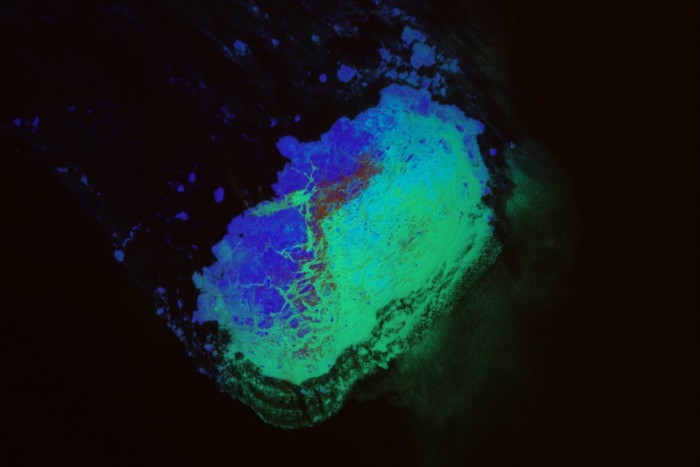Watchmakers push luminous designs to higher levels of brilliance

For a Swiss watch company, if you want your watch to glow in the dark, there’s only one man to call.
His name is Albert Paul Zeller, and he is the fourth-generation managing director of RC Tritec, a Teufen-based company specialising in the preparation, treatment, handling and use of luminous compounds. The business, which was founded in 1934 and is the only one of its type in Switzerland, is one of the most respected in the world. It has a near-monopoly on the supply of lume — as it is known — to the Swiss watch industry: in short, if it glows, he knows about it.
“I’m a semi-scientist”, says Zeller, who has degrees in both chemistry and business studies. “But, if you’re a child and your father is a chemist, you come into contact with the whole thing. I started working [in the company] on Wednesday afternoons to get a little bit of pocket money, and my father always brought us into contact with the experiments. I literally grew up in the company — we have employees who gave me the bottle when I was a baby.”
Watchmakers have been painting their dials to glow in the dark since the watch hit the wrist. In 1896, French physicist Henri Becquerel discovered radioactivity; Marie and Pierre Curie isolated radium two years later and within a decade, radium-based paints were in common usage for everything from toys to house signs, including watch dials. The harmful effects of radiation exposure were no secret, but the “radium girls” scandal of the 1920s brought the issue into the headlines. By licking their paintbrushes as they decorated watch and clock components, several women became exposed to fatal levels of radiation. Industry practices were improved but radium wasn’t banned until 1968.
Suppliers such as RC Tritec in Europe and Nemoto in Japan harnessed tritium paints, made from a far-less radioactive isotope, in the 1950s; it would be the basis for luminous dials until the early 1990s.


“At the end of the ’80s we were approached by Swatch Group, asking that we search for an alternative to tritium-activated luminous compounds, because it’s still radioactive,” says Zeller.
Zeller’s father had already come across strontium aluminate, the chemical base for today’s Super-LumiNova, “but it was a bit too grainy and too hard for watch applications,” says Zeller. “It wasn’t easy to work with, and it wasn’t as bright as tritium.” Zeller senior shared his work with Nemoto, which realised it could fix the various problems by adding rare earth metals, such as dysprosium. Nemoto patented LumiNova in 1994, and later licensed the invention back to RC Tritec. Towards the end of the decade, the two firms formed a joint venture, and by 2007, RC Tritec was able to make what it called Swiss Super-LumiNova at its factory.
“They [Nemoto] didn’t want to enter the western market,” says Zeller. “They were completely differently organised. And on the other hand, the quartz crisis left some sceptics in the western watch industry.” European brands did not want to be “dependent on Japanese manufacturers”.
Today, the two companies work in harmony, sharing knowledge and ideas at a distance, with Nemoto confining itself to the Japanese watch market. Meanwhile Super-LumiNova, which RC Tritec sells in powdered form for between SFr15 ($18) and SFr55 per gramme, together with the binding chemicals necessary to turn it into a pigment, has evolved from being merely a functional constituent of a tool watch to an essential part of the creative palette. One gramme can provide enough pigment for anywhere between 100 and 500 dials.

In recent years, watchmakers have taken to using solid 3D blocks of lume in lieu of metal hour markers or other elements of a dial. It is a product RC Tritec supplies in conjunction with a dial maker named Les Cadranniers de Genève, owned by top independent watch brand FP Journe, under the name Lumicast, and has been adopted by HYT, Vertex, Tudor, Christopher Ward and Bremont among others.
One of the earliest pioneers in the field of creative luminosity is James Thompson who, under the auspices of his Gothenburg-based materials engineering and design studio Black Badger, began making luminous rings in the 2010s. He then collaborated with brands such as MB&F, Sarpaneva and Linde Werdelin on luminous watches. Thompson worked with alternative compounds — such as the evocatively named MoonGlow — before arriving at Super-LumiNova.
“It wasn’t really anything of unbelievable quality,” says Thompson of MoonGlow. “The sheets were always a bit bent, and the lume distribution was a little wonky in it. But what that did was, it opened up a whole new avenue of working with light as a physical design tool. Instead of just painting liquid Super-LumiNova on to the hands or indices of a watch you could actually work with light as a 3D material, That got a lot of people seeing that there are options out there, that the glow doesn’t have to be an afterthought. You could actually start with whatever kind of crazy effect you wanted to have and then design outwards from that.”

This year, so far, has seen a number of brands push lume-based designs to new levels of brilliance, such as IWC’s fully luminous Ceralume pilot’s watch, launched by Lewis Hamilton in May. Also notable is an audacious electro-mechanical concept watch from Panerai, which uses micro-generators to power LED displays and is the first design to feature RC Tritec’s new, brighter-than-ever, X2 grade Super-LumiNova. Another notable model this year is a Royal Oak Concept watch from Audemars Piguet, which is the first watch to incorporate luminous pigments into a forged carbon case.
“The grade X2 shows, for white pigments, an increase in luminosity of 40 per cent,” says Zeller. “We did some calculations, and we’re still far away from what would be possible. But the problem is to transfer the theory into practice. Nowadays, we work with artificial intelligence in our research to alter more than 50 parameters which influence the luminous performance.”
To fulfil the watch world’s creative needs — and to cater to its other, non-horological clients which Zeller says make up 45 per cent of the company’s business, and include medical imaging and drug tracing technology as well as “neutron detectors looking for water on Mars”) — RC Tritec recruits from far and wide.
“Our people are mostly chemists or have a science background,” says Zeller. “But we look for people with a strong sensitivity for fine work with pleasure in creating beautiful things. We have people who have been working as painters or in bakeries. After a while, if you work for our company, you get watch-addicted.”
#Watchmakers #push #luminous #designs #higher #levels #brilliance




